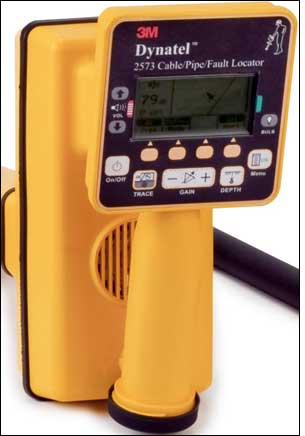Last month, 3M introduced the next generation of its RFID-enabled system for locating underground pipes and cables. The company reports that its Dynatel 2500 series features more active and passive frequencies, higher power and a new trace view mode. Thanks to the upgrades, the firm indicates, the 2500 series locators can now identify pipes and cables buried more deeply in the ground that previous models. The mapping display on the locator’s built-in LCD screen draws the positions of the cables and the pipes in the ground, to easily identify their locations.
The new series has six frequencies for locating cable and pipe—a process that employs a separate transmitter that sends out a tone used by the handheld locator to trace the course of the pipes and cables. (The expanded frequency set adds 1 kHz and 82 kHz to the existing 577 Hz, 8 kHz, 33 kHz and 200 kHz frequencies used by older Dynatel models.)
The 2500 series locators also have an integrated RFID reader and writer that can locate passive RFID markers operating at any of seven separate frequencies. What’s more, the locators have the capability to operate in trace and RFID modes simultaneously.
There are four different form factors of RFID-enabled markers—near-surface, disk, ball and full-range—each of which contains a passive RFID chip with 256 bits of memory, enabling users to program additional data on the chip. Depending on the model, the markers’ detection ranges vary from 3 feet underground (for near-surface) to 8 feet (for full-range). The ball markers, for instance, have a read range of 5 feet. Each 4-inch-wide, high-density polyethylene plastic ball contains a coil antenna and a passive RFID chip floating in a liquid combining water and biodegradable propylene glycol. Since the RFID tag floats, it can automatically align itself in the best orientation for receiving and transmitting RF signals.
A new, unique feature in the 2500 series offers a “trace view” mode that transfers the signal to a mapping display, which simplifies the ability to locate a pipe or cable. The new series also increases sensitivity in this mode by 500 percent. The maximum power output now has a 12-watt transmitter with improved induction capabilities for applying trace signals to locate buried cables and pipes. For field applications with limited facility access, the 2500 series introduces a larger, 4.5-inch Dynacoupler—an inductive clamp that goes around a cable or pipe to apply the locator trace signal.
The 2550-ID and 2573-ID locators can detect all standard low-frequency passive RFID markers, as well as write, read and lock programmed information into 3M’s RFID electronic markers. Old-school locators required workers to swing a wand aboveground where they thought a cable or other object was buried, according to Corey Willson, 3M Track and Trace Solutions’ business development manager for locating and marking. These locators can read the signal transmitted from markers deeper in the ground. Each marker’s location then appears on the LCD monitor, thus making it easier to find.
Willson calls this series of locators “super-intelligent,” because the mapping module provides a visual representation and coordinates for the pipe or cable. “It’s kind of like having X-ray glasses into the ground,” he says. “They’re designed to be more accurate.”
According to Wilson, utility service companies will begin to see more devices with services that offer a variety of functions for field workers. Additionally, he notes, locators will also integrate more easily with back-office systems.
“Before anyone sticks a shovel in the ground for new construction or bury utilities, they need to call before they dig,” Wilson states. “Anytime someone buries a utility in the ground, builds a building, extends broadband or increases a distribution network, they need to use a locator to find the utility. They bury a marker to help them locate the utility line.”
As collecting and logging that data on utility lines becomes more complicated, Wilson says, 3M’s challenge to expand the devices’ integration means keeping tools simple and intuitive. This, he adds, will reduce the learning curve and increase productivity.
The company offers two main interfaces to upload the information. One way allows workers to store data in the locator while in the field, and then upload that information to the PC upon returning to the office. The other is to combine trace and RFID data with location information supplied by a GPS receiver mounted on the locator, and then upload the linked data into a back-office system, such as ESRI‘s geographic information system (GIS) software.
Similar to other Dynatel units offered by 3M, the 2500 series locators provide pipe, cable or sonde depth measurements, offering a digital readout either in feet and inches, or in centimeters. The locators also provide a direction indication to the cable, in order to help the operator distinguish the target object in congested areas.



